The RV6 has arrived! Flown over from Dublin on a blustery day and now safe in the hangar. Flying report to follow, but here’s a few piccies:
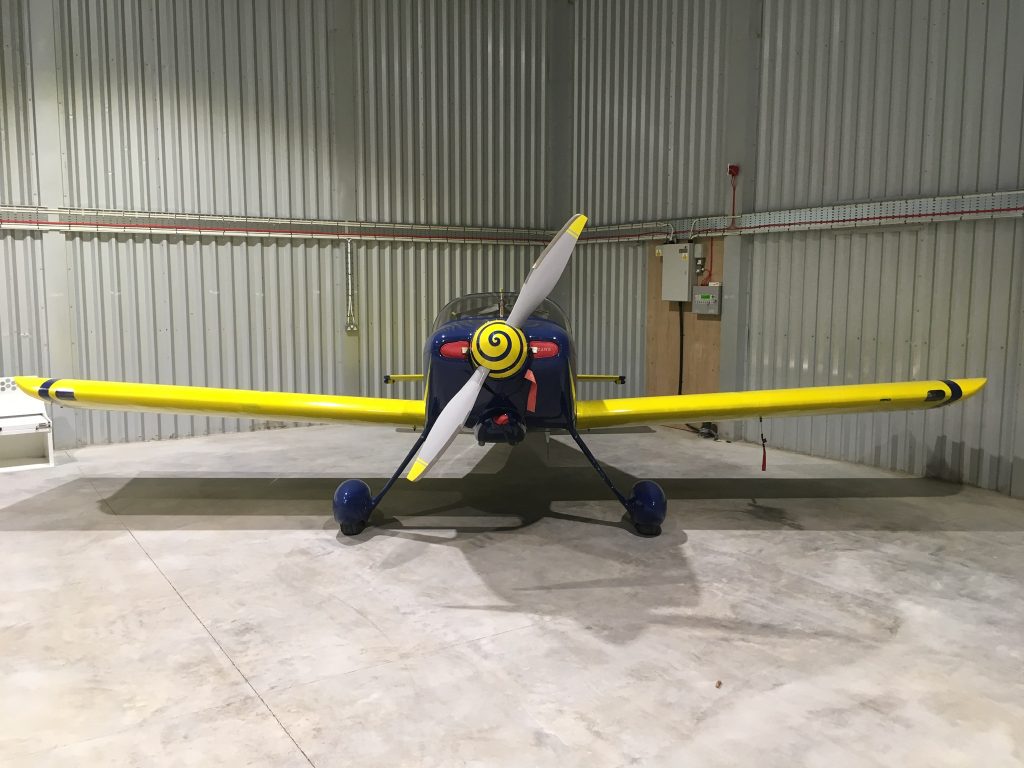
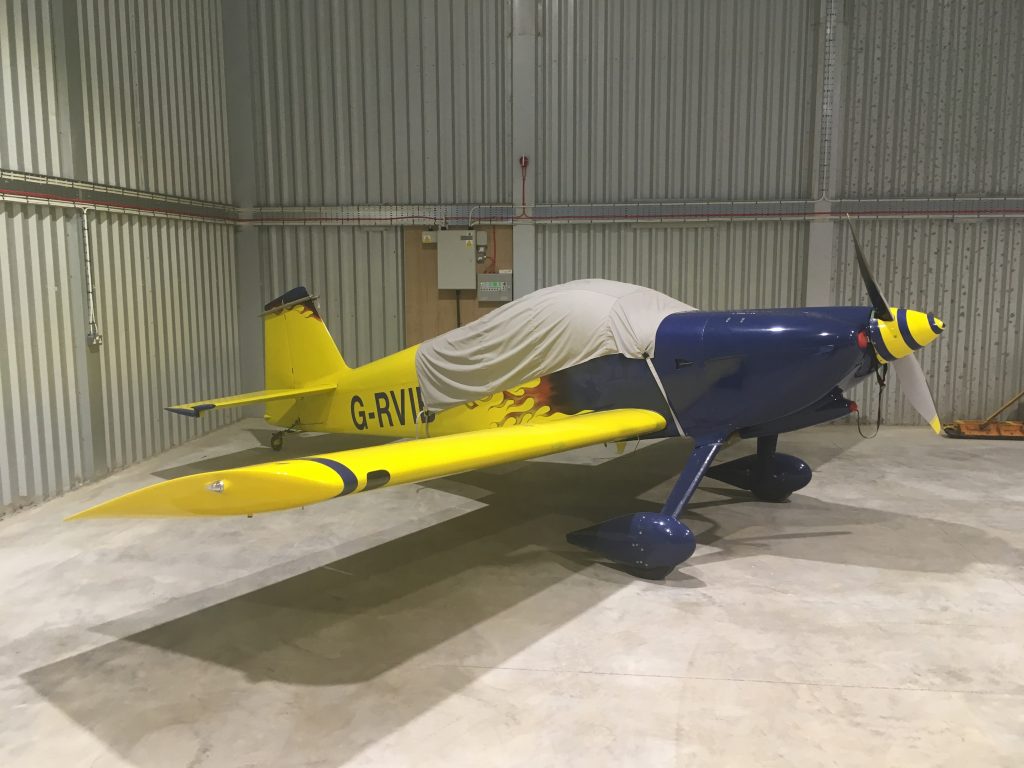
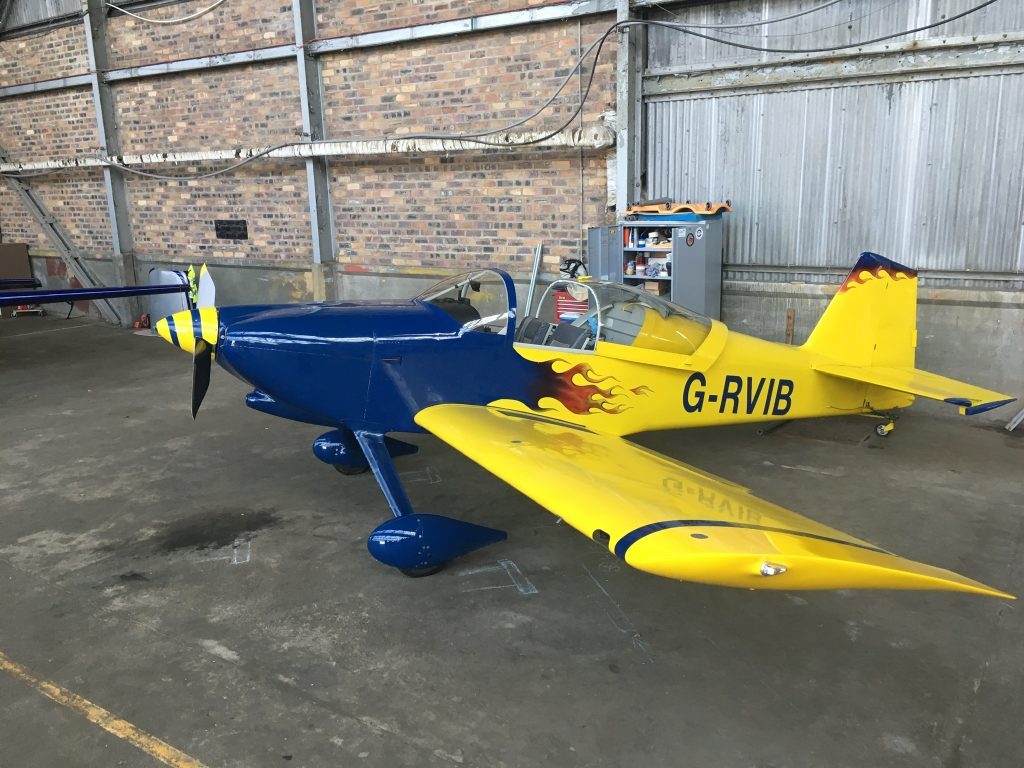
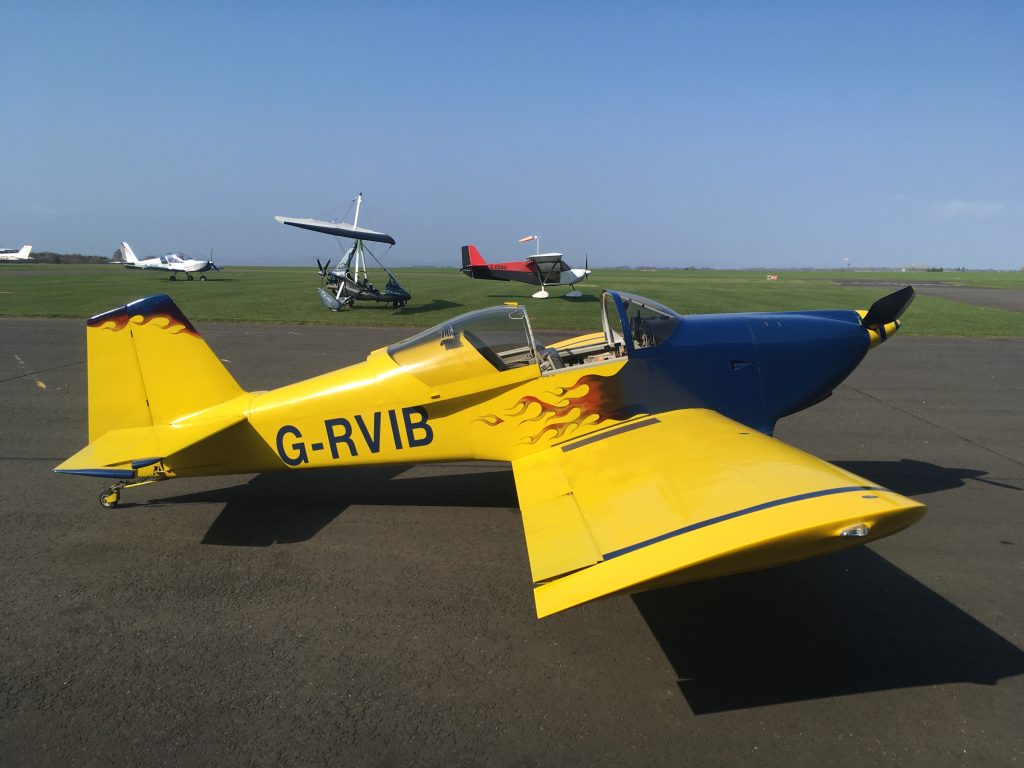
Adventures with aircraft, and other random stuff…
We mentioned going to Dublin to view an aircraft which was for sale. Here it is:
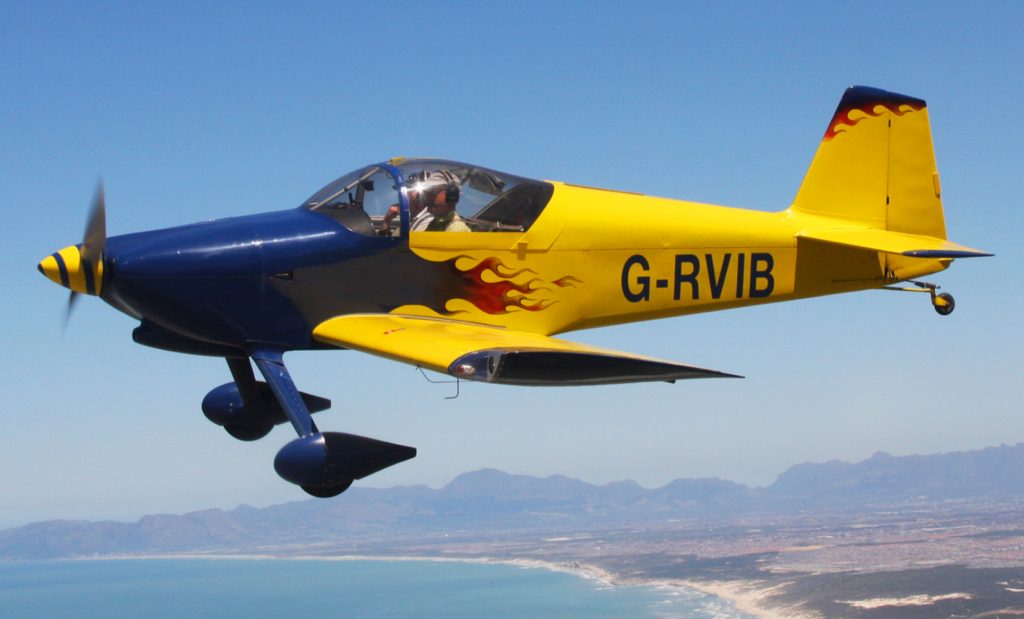
It’s a VANS RV6, built from a kit produced in Oregon. Both of my loyal readers may remember my trip to Inverness to view an RV-7 last year, and the subsequent purchase of a preview plans set (see April 2018 – for some reason I can’t embed a link here).
Vans are the most popular kit planes out there, with over 10,000 flying worldwide. G-RVIB was completed in 2002 and since then has flown about 1700hrs, including a monster epic trip to Cape Town. As it was for sale, and the price was right, and we could bypass the build process, we decided to go and have a look.
We took the ferry from Scotland and drove to Weston Airfield on the edge of Dublin. There we met the owner and saw the aircraft in the hangar:
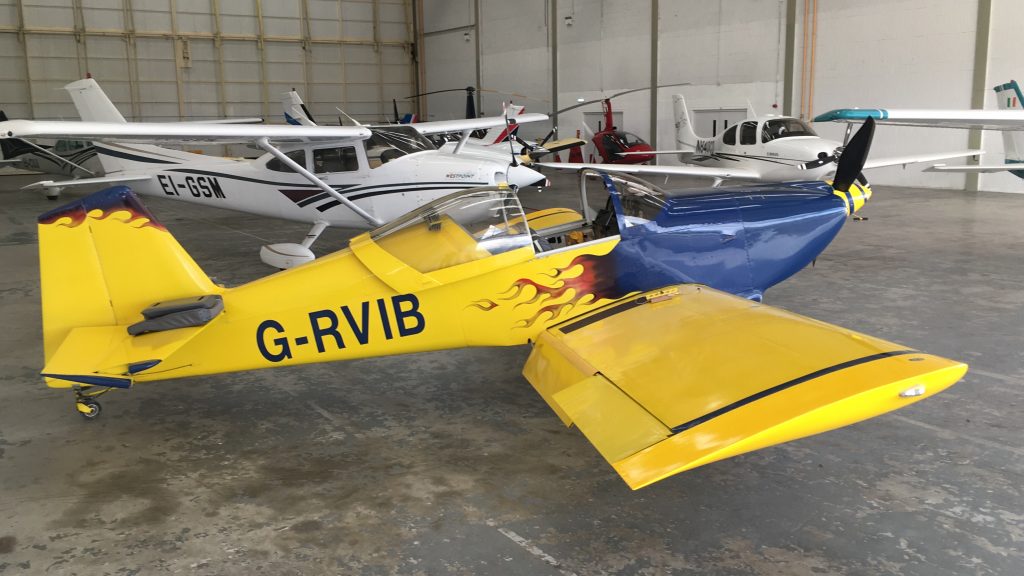
First things first. Do I fit.? Do both of us fit? We went to see a lovely Lancair in the summer and while we did fit in it in terms of legroom, width and so on, we couldn’t get the canopy closed. So we had to let that one go.
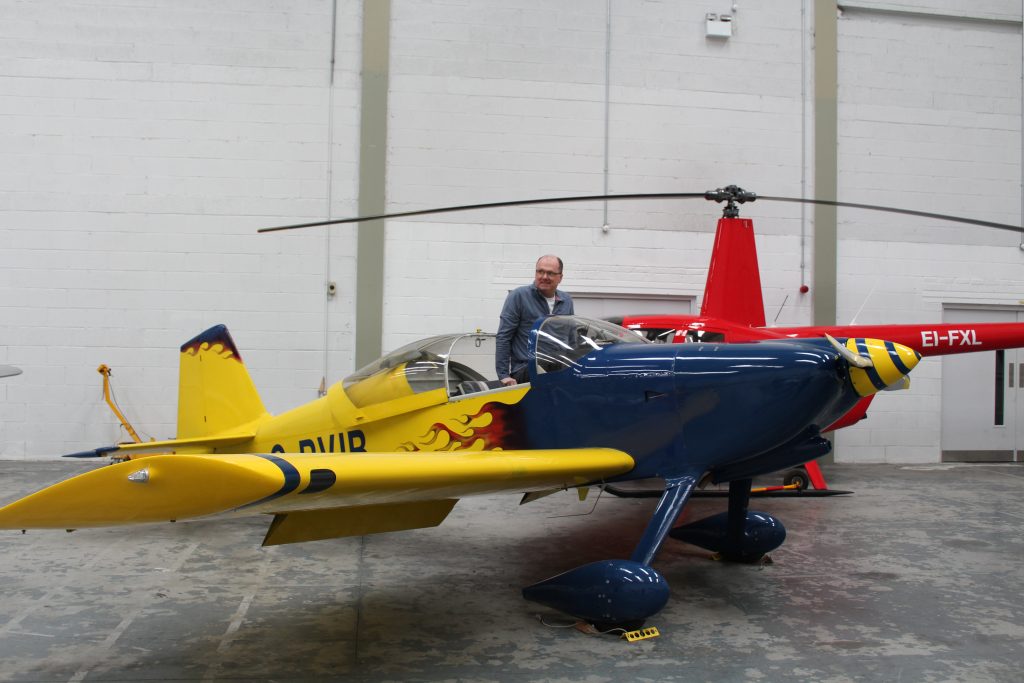
Luckily there was headroom for both of us with headsets, so we got onto the serious stuff. First a good look at the cockpit and instrument panel:
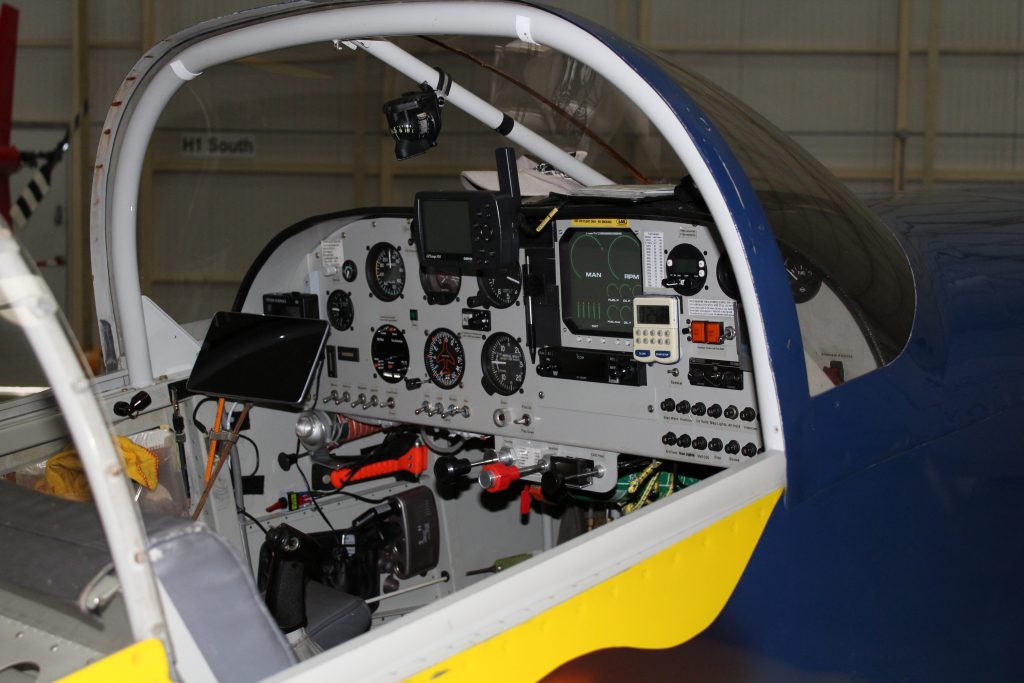
The panel is well equipped, with good avionics (8.33 radio and Mode-S transponder), digital engine monitor, GPS unit feeding info to the autopilot and a tablet running Skydemon. Comfortable side by side seating with loads of legroom. The two red lights on the right are low fuel warnings for the auxiliary tanks installed in the wingtips – these increase capacity from 140 litres to about 210 giving up to 9 hours endurance if flown properly. My bladder would have exploded by then.
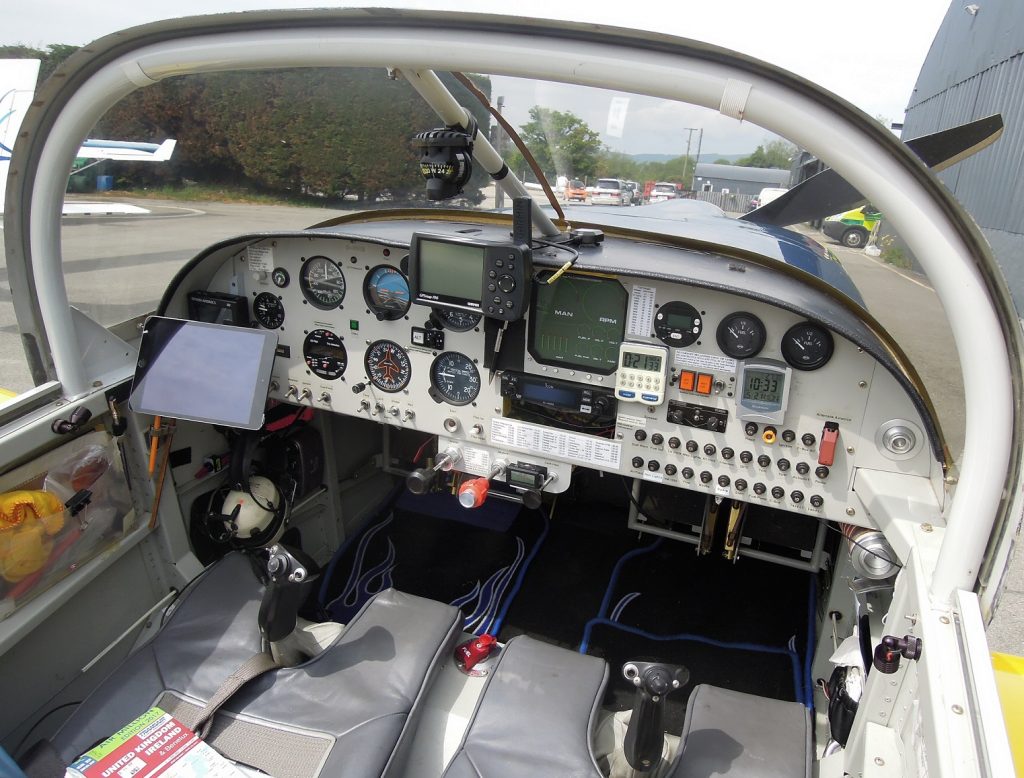
Notice the control columns festooned with buttons and switches. This is one half of what the military call HOTAS (Hands On Throttle And Stick) which means every button and switch you may need in flight is at your fingertips. No need to take your hands from the controls. In something meaty like an F/A-18 your fingertips can control talking on the radio, selecting and firing different weapons, operating the radar, changing the cockpit displays, switching from air-to-air mode to air-to-ground mode and many others. In this case there is a push-to-talk for the radio, elevator trim control, aileron trim control, autopilot disconnect, flap control and bomb release. I made the last one up.
Then it was time to inspect the engine…
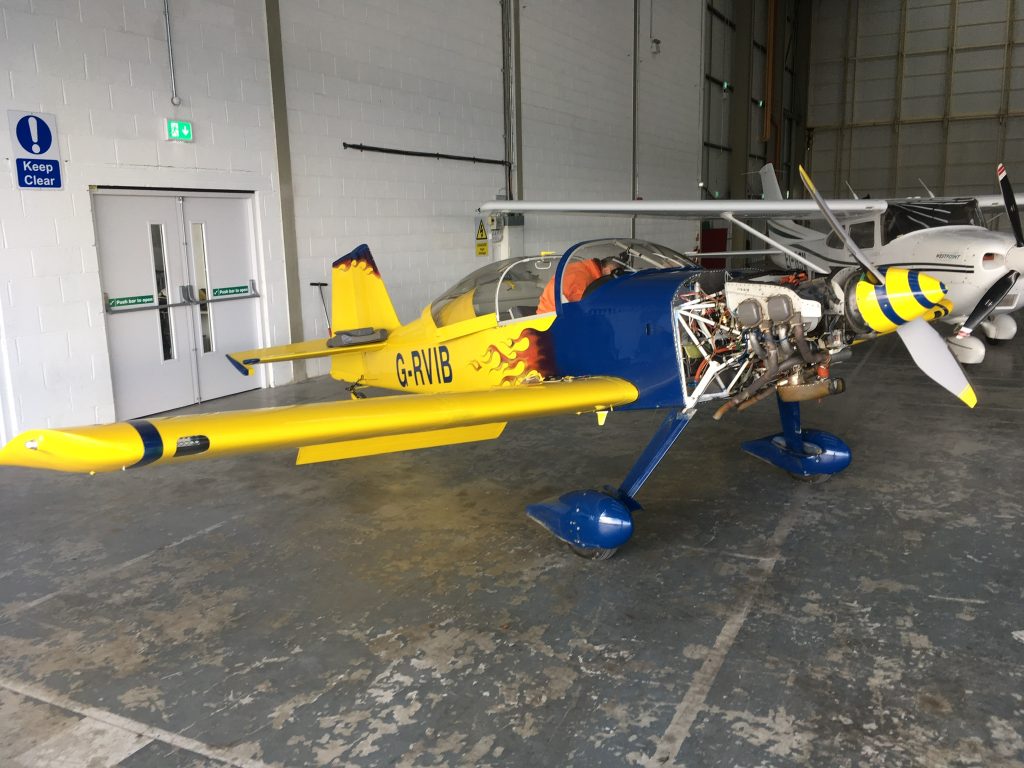
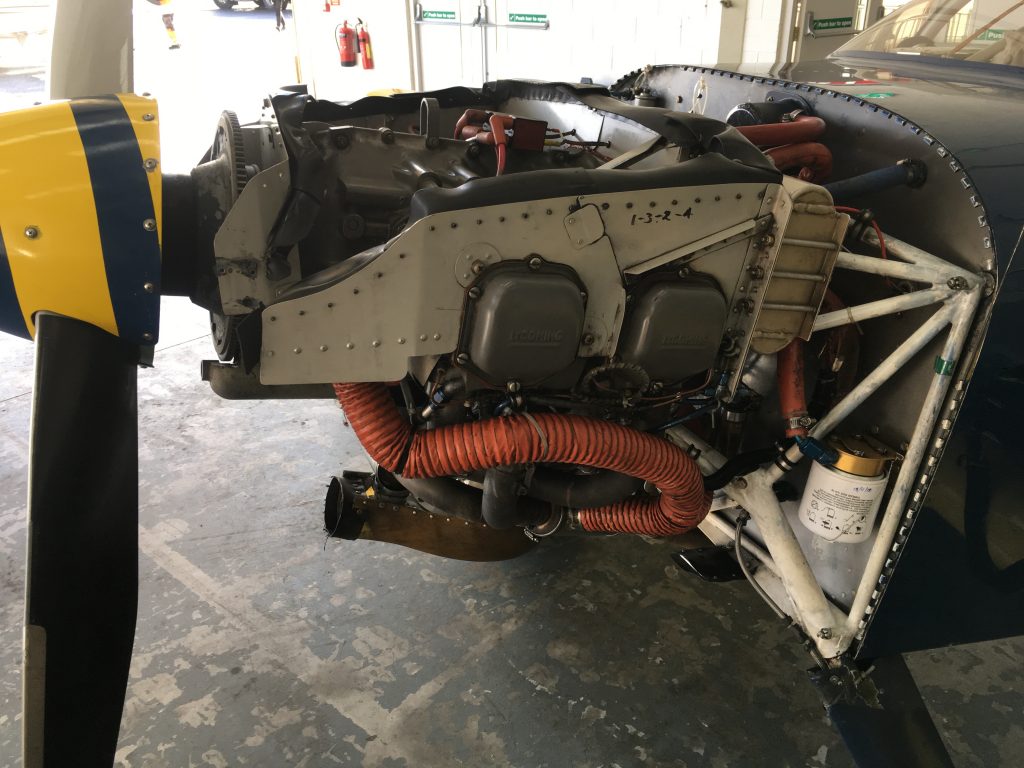
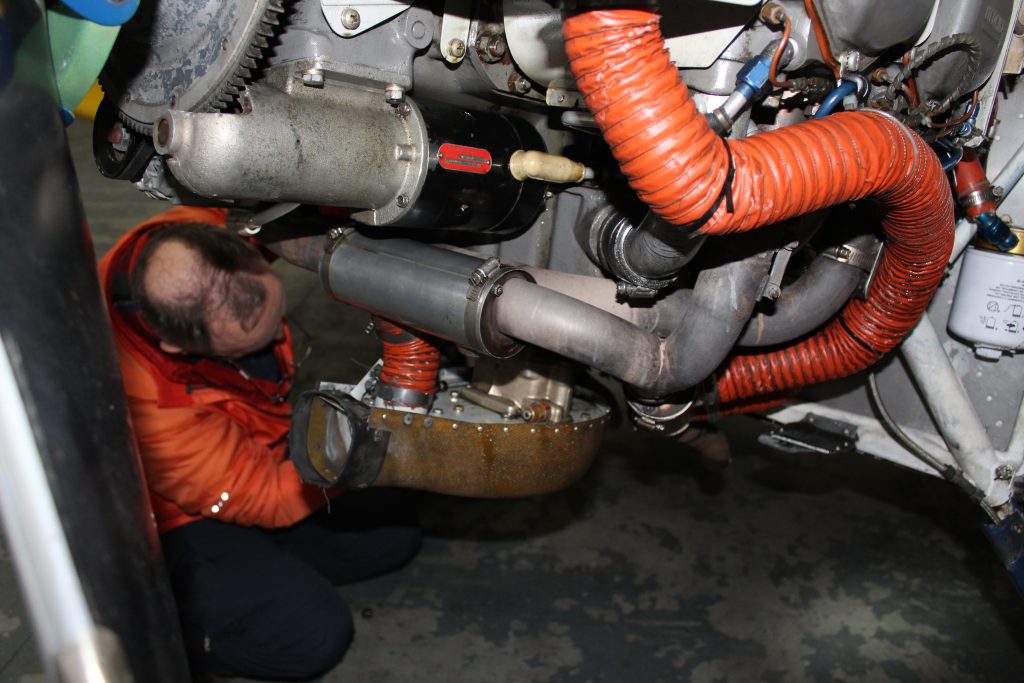
And a look under the seats at all the stuff under there:
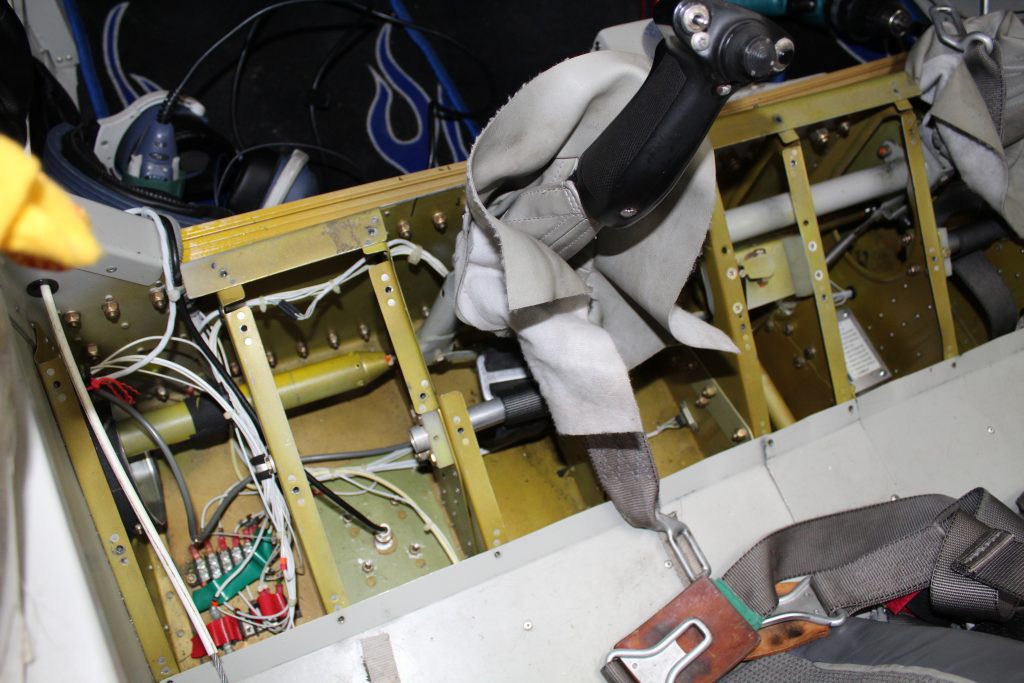
Once we’d looked at all that we could look at it was time to go for a quick flight…
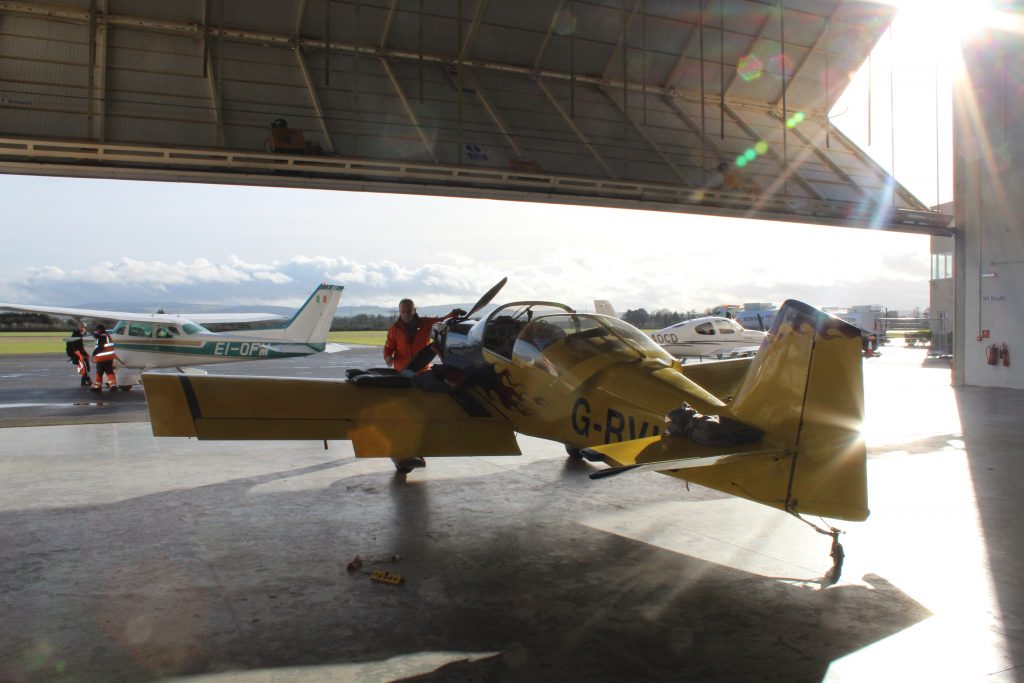
No photos of the flight, I was too busy having fun. Brenda was watching from the restaurant and said the takeoff seemed really quick. The aircraft has a fixed pitch cruise prop so I wasn’t expecting anything sparkling but even so, the ground roll seemed quite short.
What was interesting was the fact that as we accelerated, the prop was getting more and more efficient, and the speed just kept building up. I didn’t notice the speed at which we broke ground, but the sight picture was all wrong as we whipped over the airfield boundary in a gentle climbing turn to the right…I did glance in to check and saw 120 knots on the ASI, that’s 50 knots faster than the Sting would be going at the same point.
Levelling off under the Dublin TMA we continued to accelerate. Peter says the flat out cruise at low level is about 160 knots. Throttling back a little to save fuel can still give a respectable 140 knots – 20 faster than the Sting so good for going places.
Peter loves fuel efficiency. He has found that throttling right back to about 50% gives an indicated airspeed of 125 while flying at 8000 feet and a true airspeed of 135, while getting 5 nautical miles for every litre of fuel burnt. Great for going long distances, although we might have to buy some NASA nappies.
We floated around Ireland for a bit:
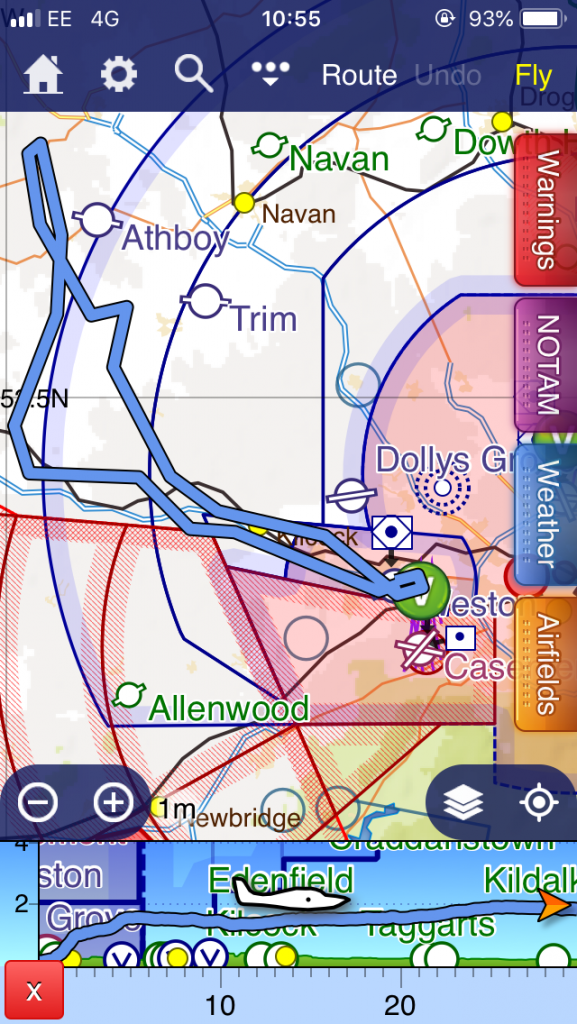
After landing I decided that I REALLY like this aircraft, but didn’t want to jump head first into anything. We agreed to meet the next day at the airfield for more discussion. I took the engineering worksheet folder to the hotel for some light reading and found it to be very well organised and neat, a complete record of work done on the aircraft since the beginning…if the paperwork is meticulous it gives an idea of the mentality of the owner and their attitude towards maintenance.
In this case, Peter is an accountant so it may just be “accountant’s neat” – but the aircraft and paperwork together offered a compelling argument.
So, YES, we agreed to buy the RV6. Excited!
The only problem is the registration. Sigurd Martin is Swedish phonetic alphabet for SM, the registration of the Sting. India Bravo translates as Ivar Bertil.
There is no way I’m changing the blog name to Ivar Bertil. No way. Sigurd Martin will just have to stand for something else. Like…Speed Machine?
A trio of February flights in cold, clear, still weather. In fact there was no wind, perfect for the Eindecker but it would have been far too cold for the pilot…
Here’s the Sting using the power of the sun to warm up on the grass. Refuelling is by jerrycan but the aircraft has to be on the grass. Any spillages on the tarmac dissolve the stuff and are frowned upon. Because of this, we usually push the aircraft out of the hangar, then start the engine and taxi onto the grass. It also helps to warm the engine, making starting a lot easier when we actually do go flying.
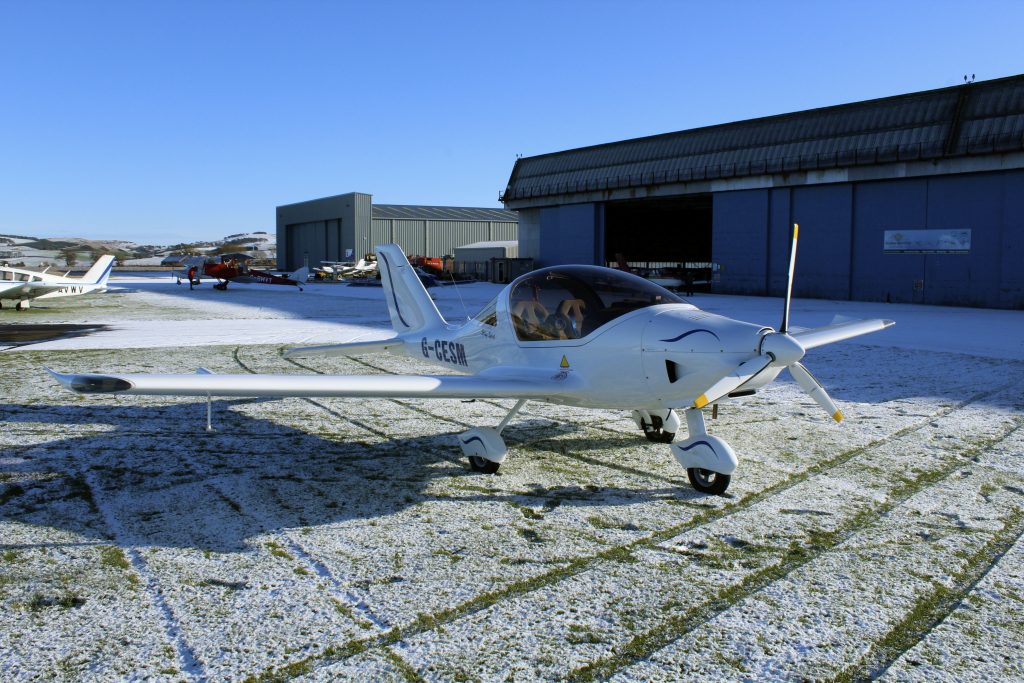
Making our way down runway 09 to the grass runway 33. Normally at this time of year the grass runway is waterlogged and unusable, but with freezing temperatures after a dry spell it’s now just hard. Perfectly usable.
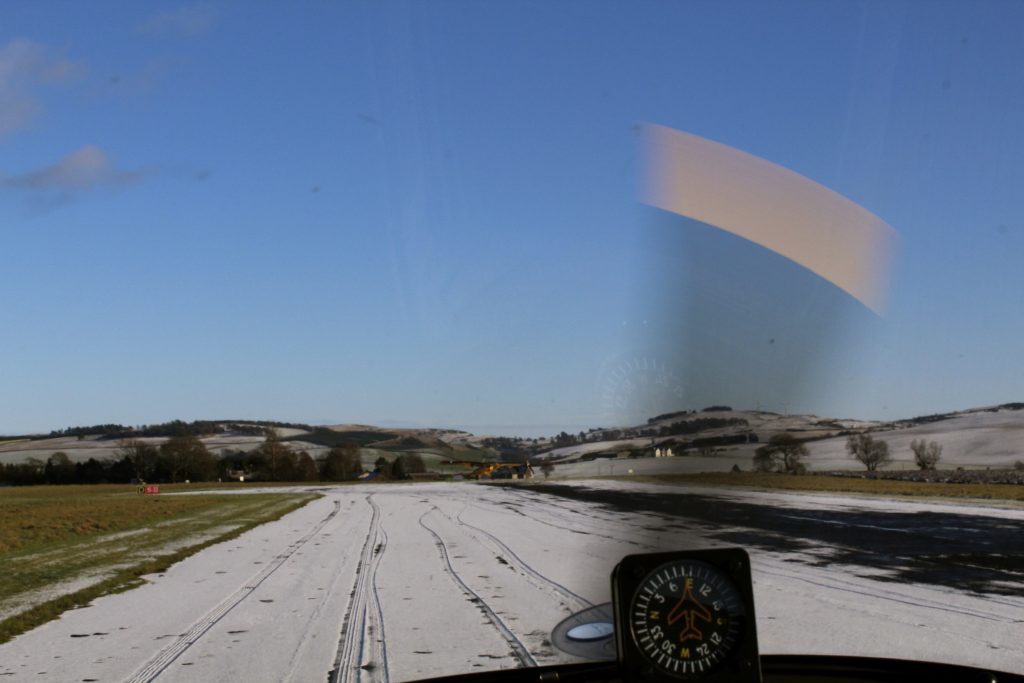
The Skydemon trace of the trip up to the hills:
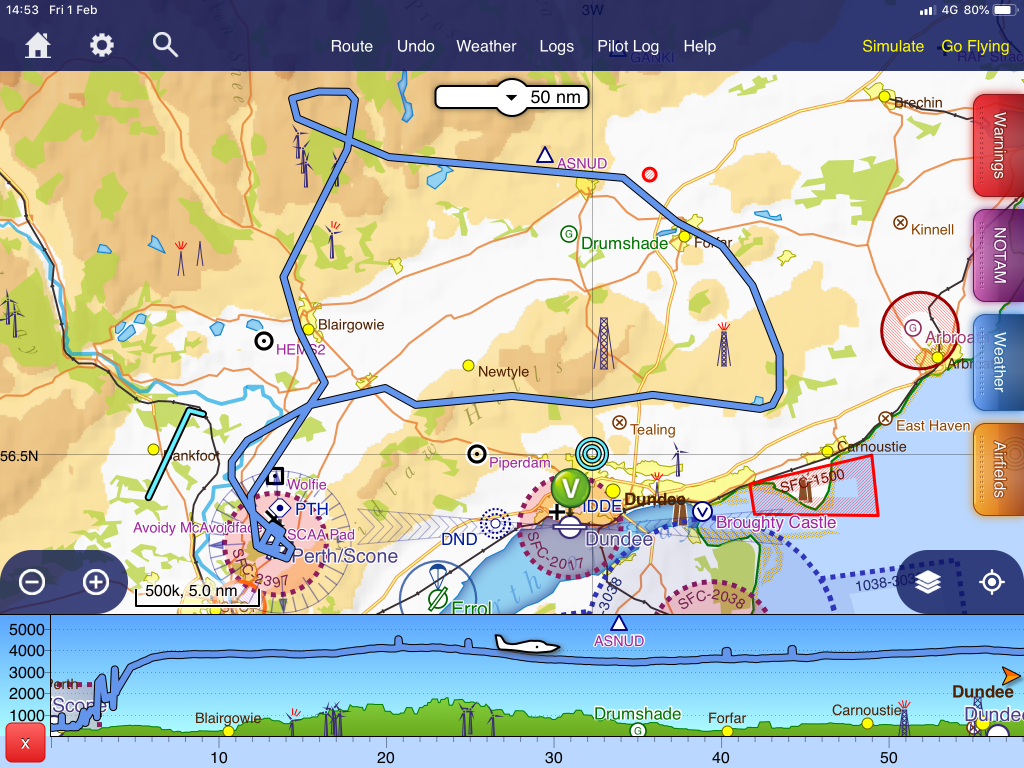
The view north from the edge of the hills. There’s another aircraft somewhere in this picture. Click on the picture to view the big version and see if you can spot it…a head-to-head competition between both my readers!
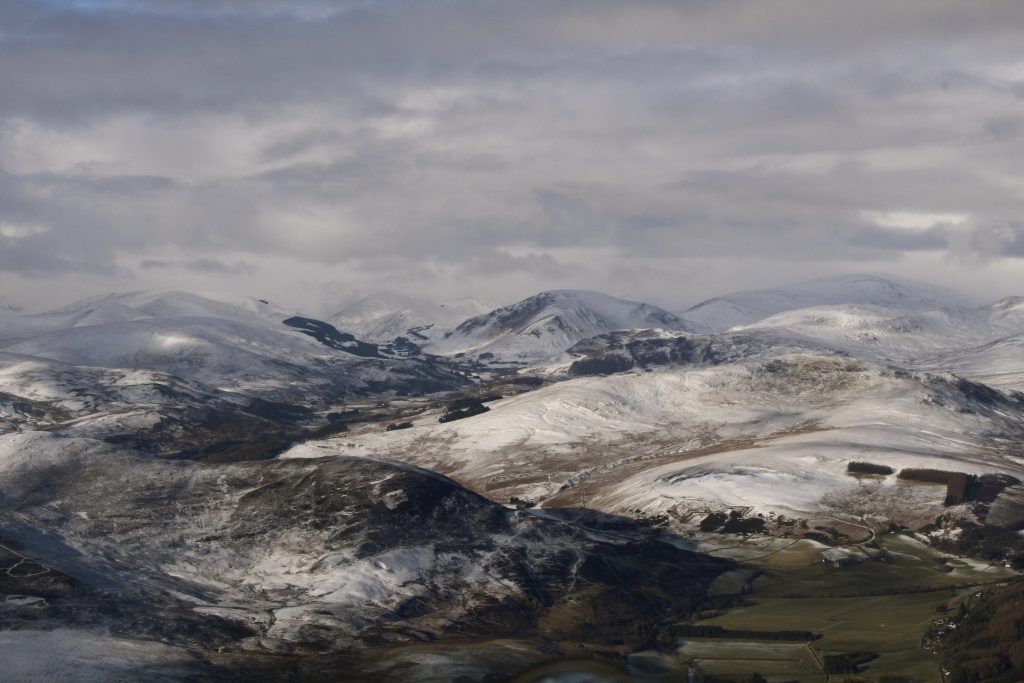
Snow coverage was patchy. Here we are east of Kirriemuir. The industrial complex within the woods in the centre of the picture is what’s known in the trade as a GVS. It stands for gas venting station and this has an avoid area around it up to 2900 feet. On occasions the pipelines need to be vented for maintenance or cleaning and when they do a column of high pressure natural gas comes up into the atmosphere. It doesn’t happen very often but when it does you don’t want to be flying through the plume. Engines and humans don’t run very well when there’s no oxygen to breathe, so it’s best to keep away…
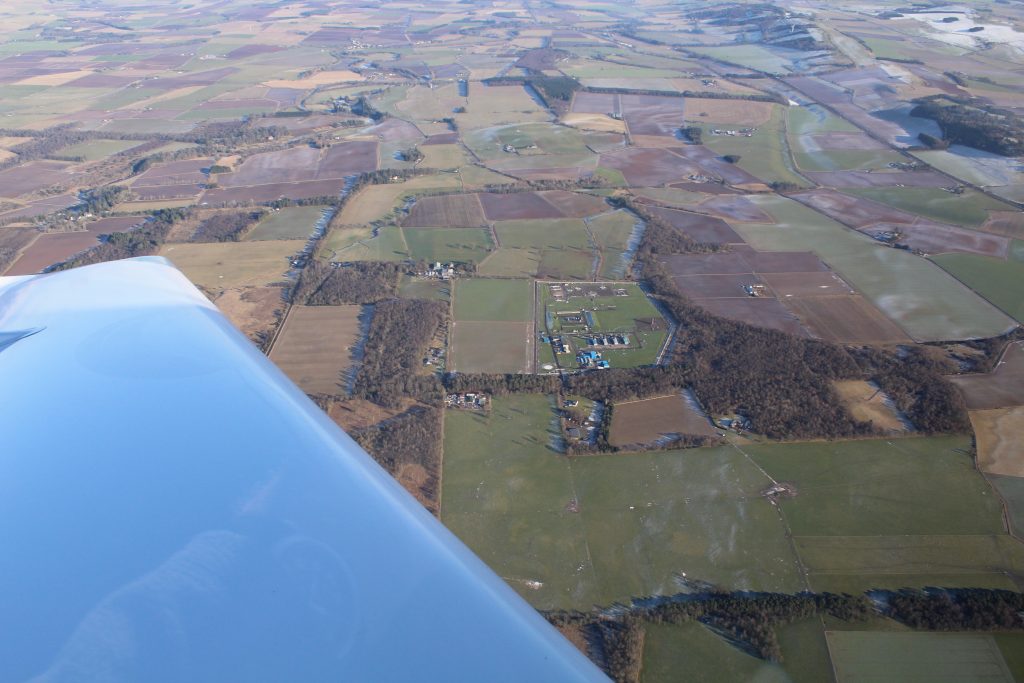
Winter flying is great. The aircraft and engine perform better in the cold air. By the time we got back to Perth the snow was mostly melted, apart from in the shadow of the hangar. The Tiger Moth was just going up for a jaunt – that must have been COLD. Not taking the Eindecker was a good decision.
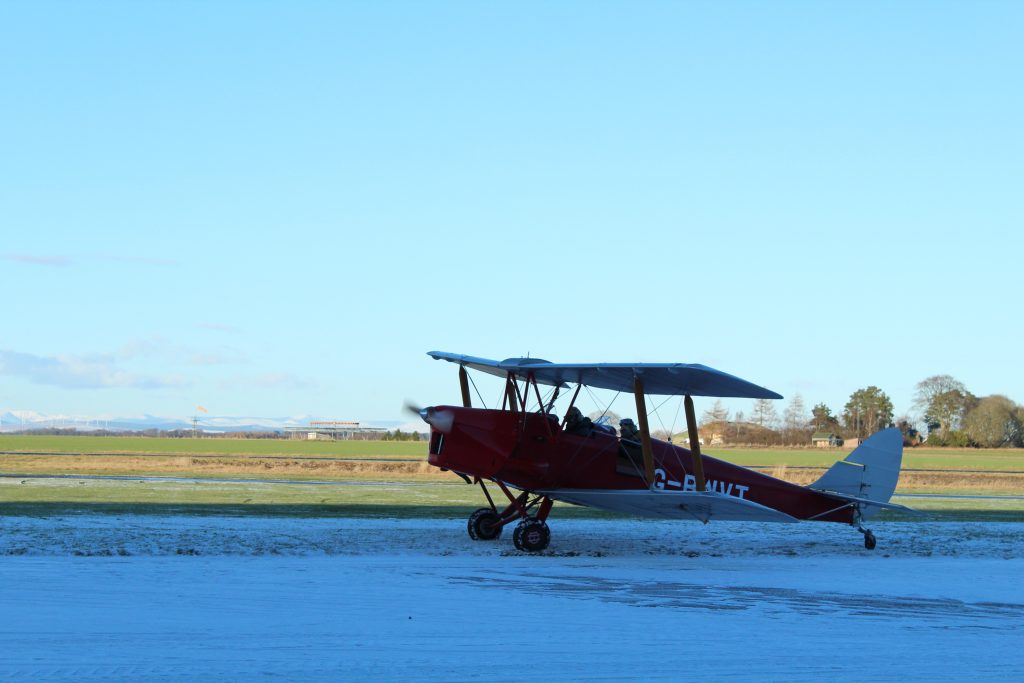
Clear and dry the next day, with a bit more snow overnight. Time for a trip over Fife…
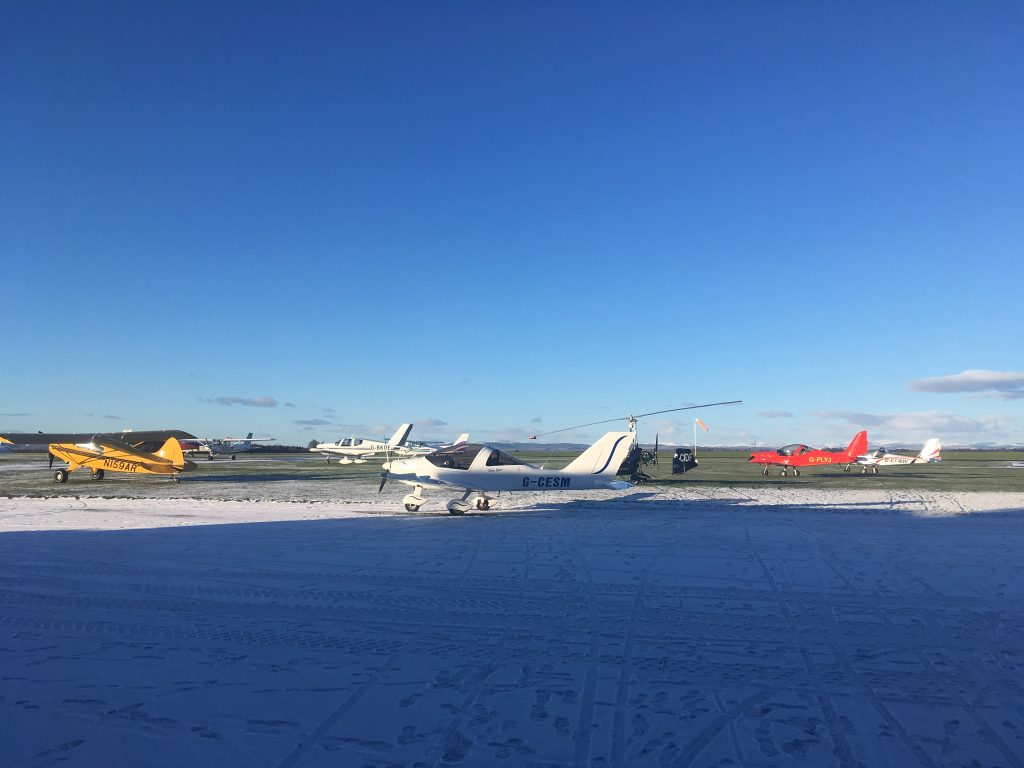
The trace of the flight: east from Perth around the north of Dundee with more snow on the ground…
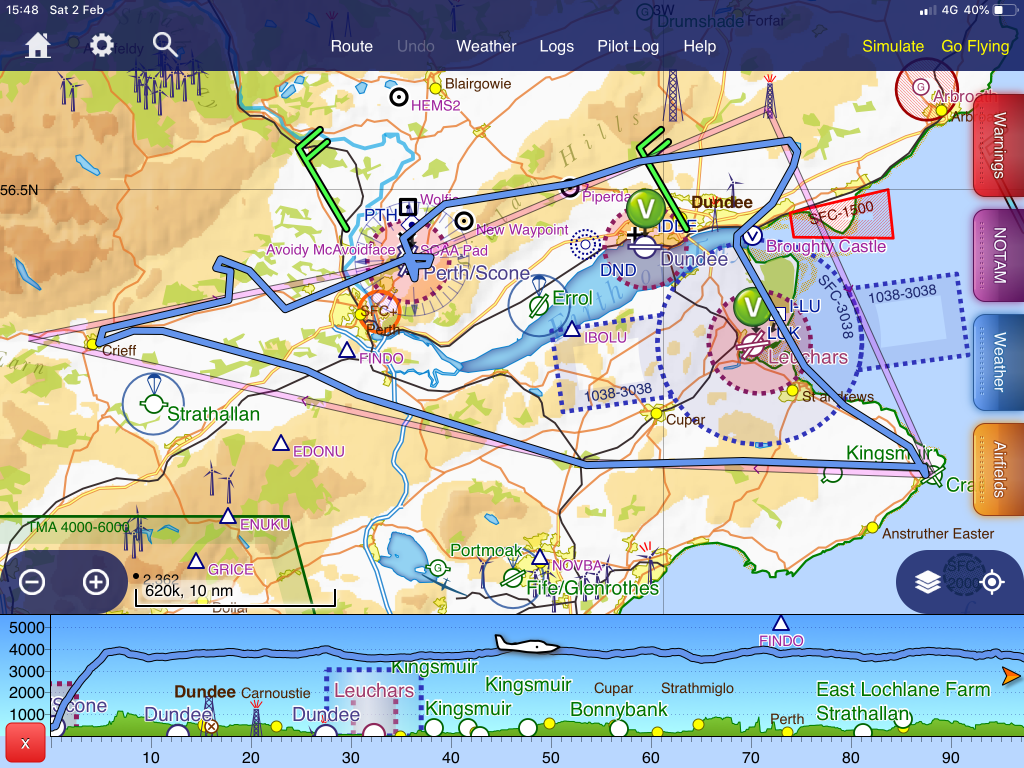
The turning point at Monikie Reservoir was really hard to make out. It turns out that frozen water with snow on top looks just like a field from 4000 ft.
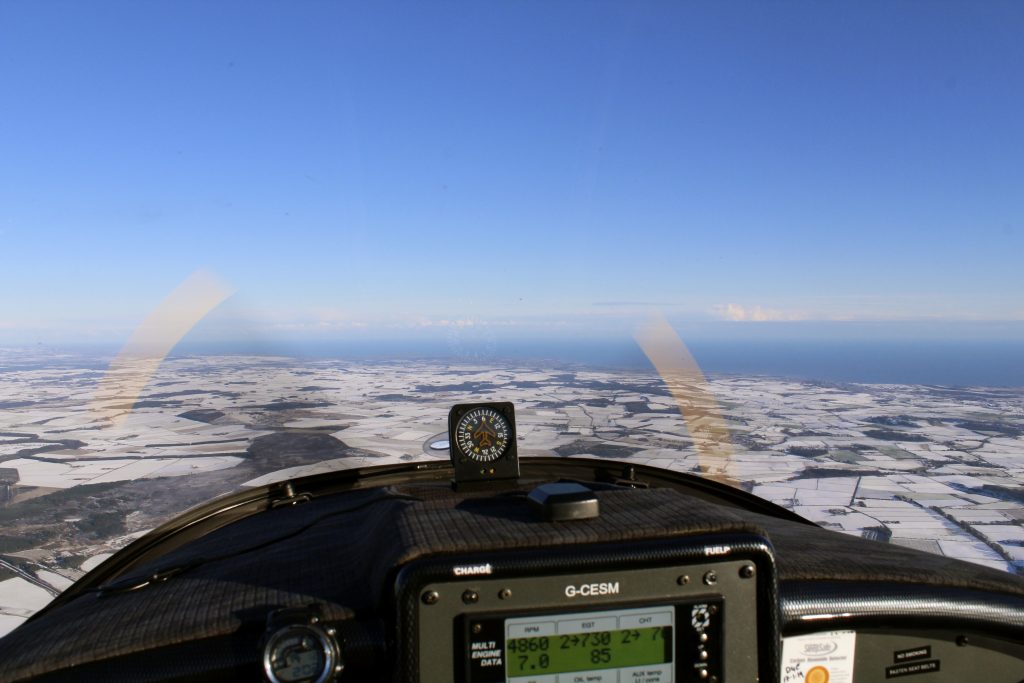
Snow on the Sidlaw hills:
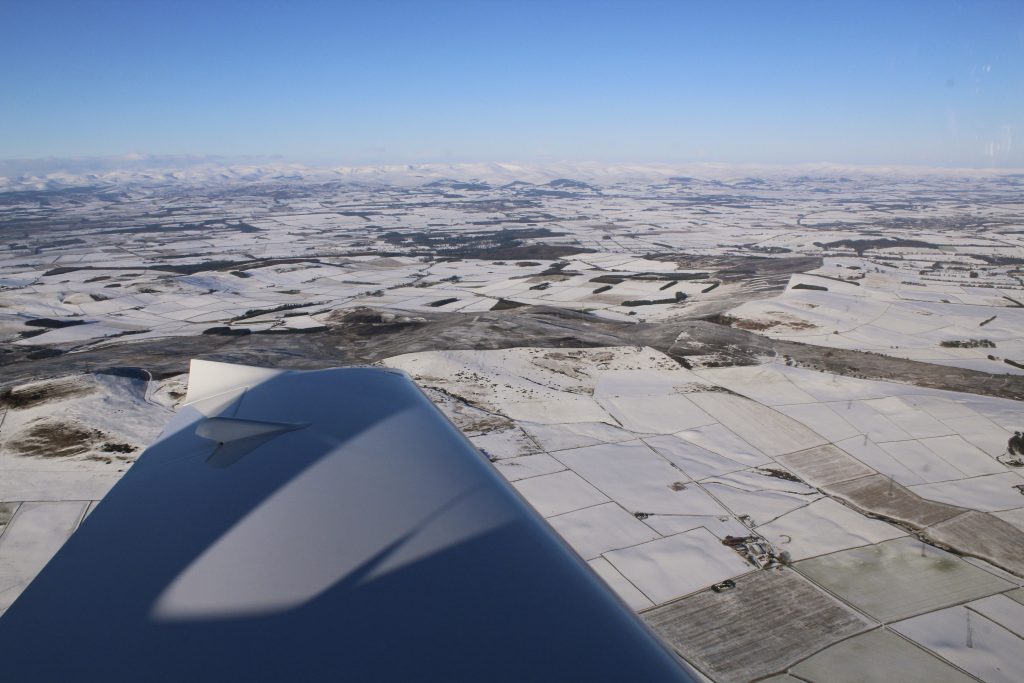
Dundee from 4000ft:
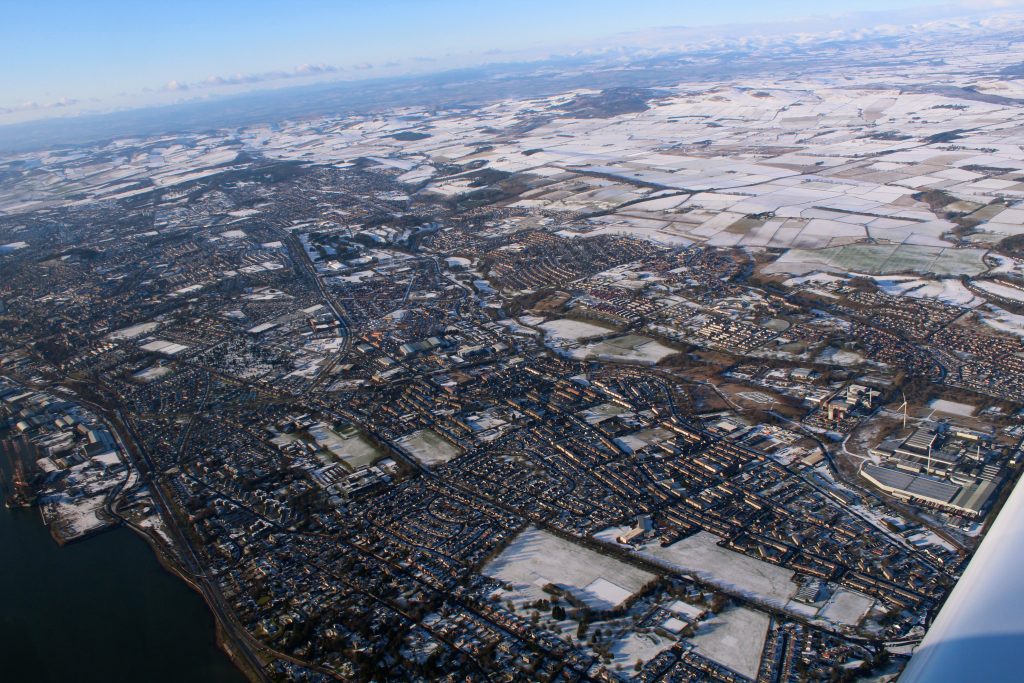
Once into Fife there was a distinct line on the ground where the snow finished. No gentle change, one field had snow and the next was clear. This next wing view shows the former Naval Air Station at Crail on the tip of Fife. It was known as HMS Jackdaw, and is acknowledged as the best preserved abandoned military airfield in Scotland. You can still land there, but one of the old runways is now a drag racing strip.
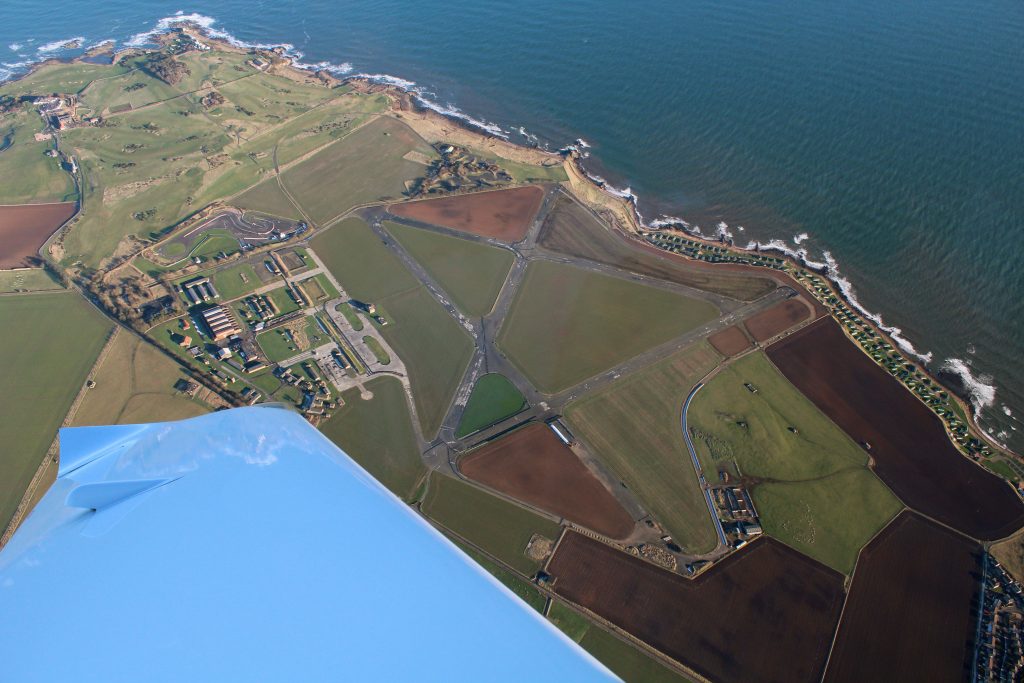
By now we were down to 3500 ft, and with the power settings just right were getting 120 kts indicated air speed:
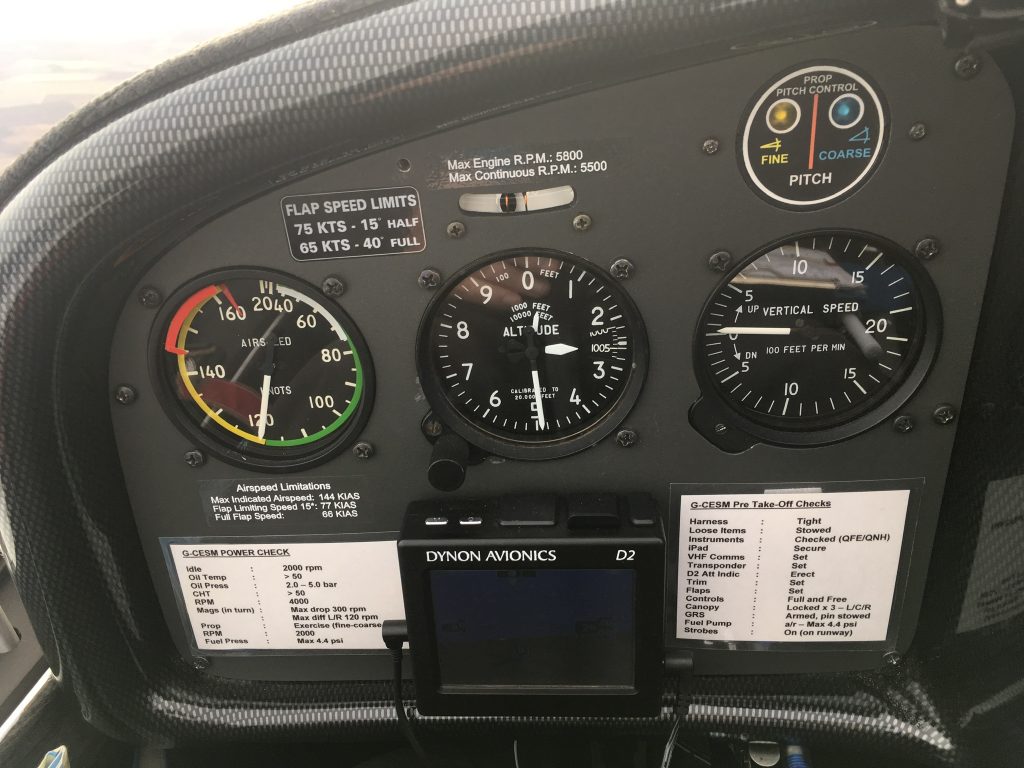
Once back at Perth it was starting to cloud over. The forecast for the next 48 hours was pretty dire, precluding any thought of aviating. My run of flying every day in February lasted for just two days.
I love putting the aircraft away in the hangar after a winter flight. The engine is still warm as you put the covers on. It’s a different type of warmth. Sure it’s just molecules vibrating at higher frequencies because they have more energy, but it feels totally different from putting your hand on a warm heater. The difference is that the heat is a slowly dissipating memory of when the engine was working, powering the aircraft through the sky, giving the occupants unique memories of their own, having defied gravity one more time. I call it “The warmth of achievement” – I quite like the term.
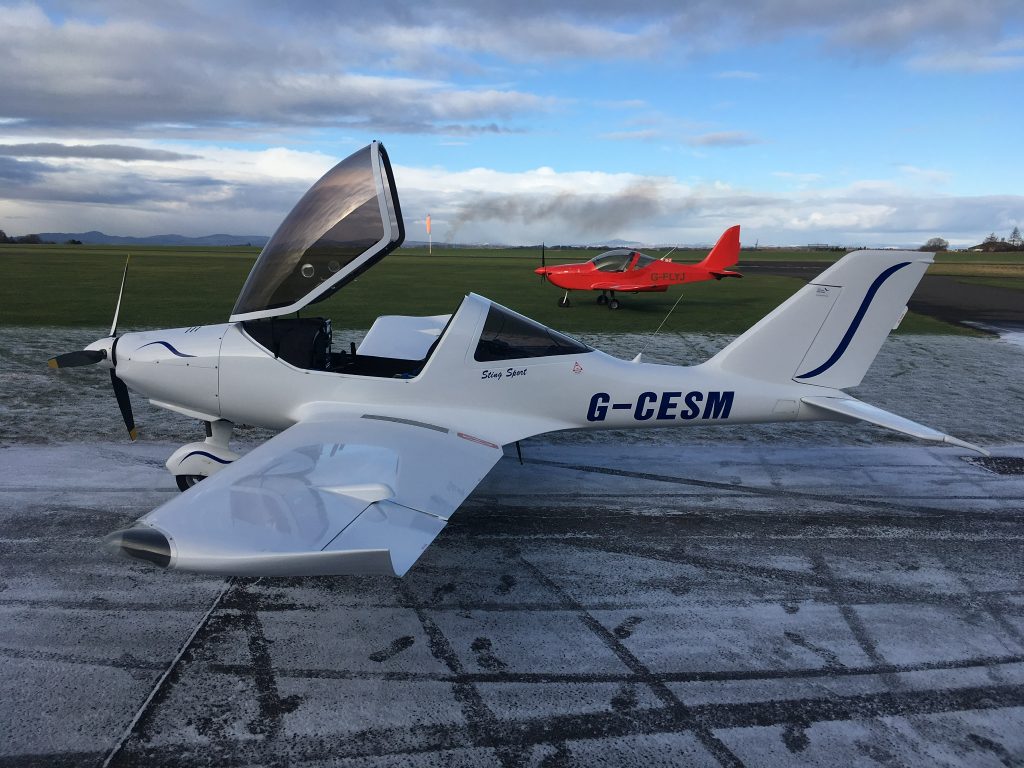
On the 5th the weather cleared enough for a quick trip round the local area:
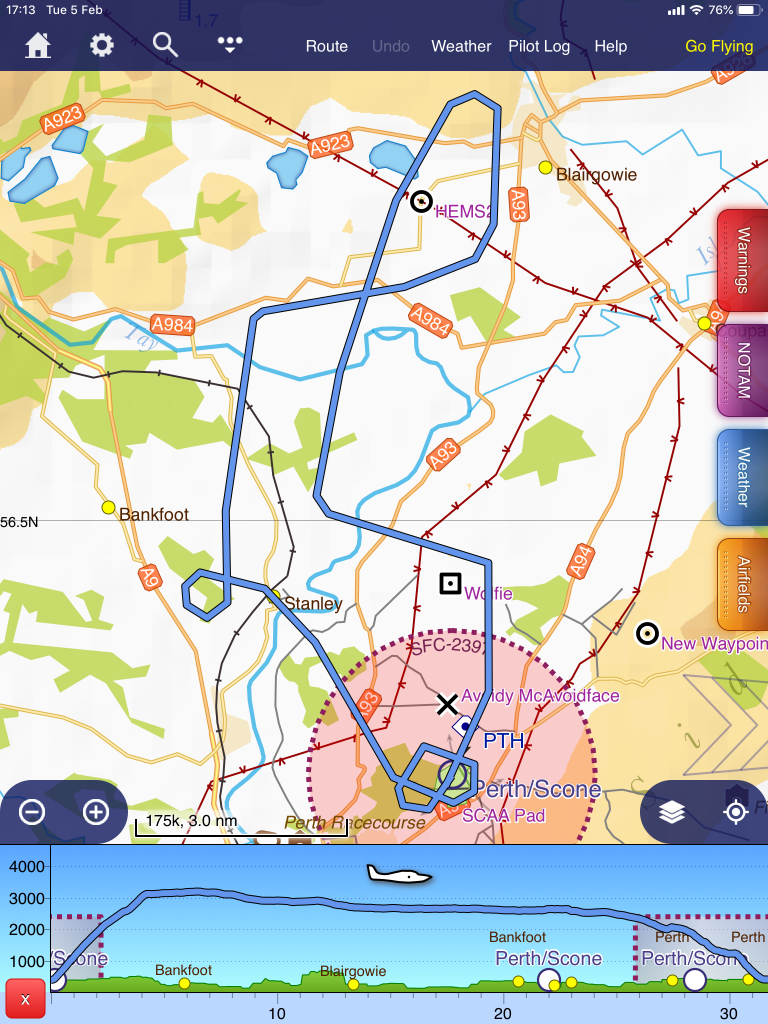
And we even managed to get 125 knots, although looking at the Skydemon altitude trace above the speed might have had a little bit of a gravity assist – not defying gravity 100% but just like NASA, using the gravity well of a planet to add energy. Does that make me an astronaut? Space cadet more like.
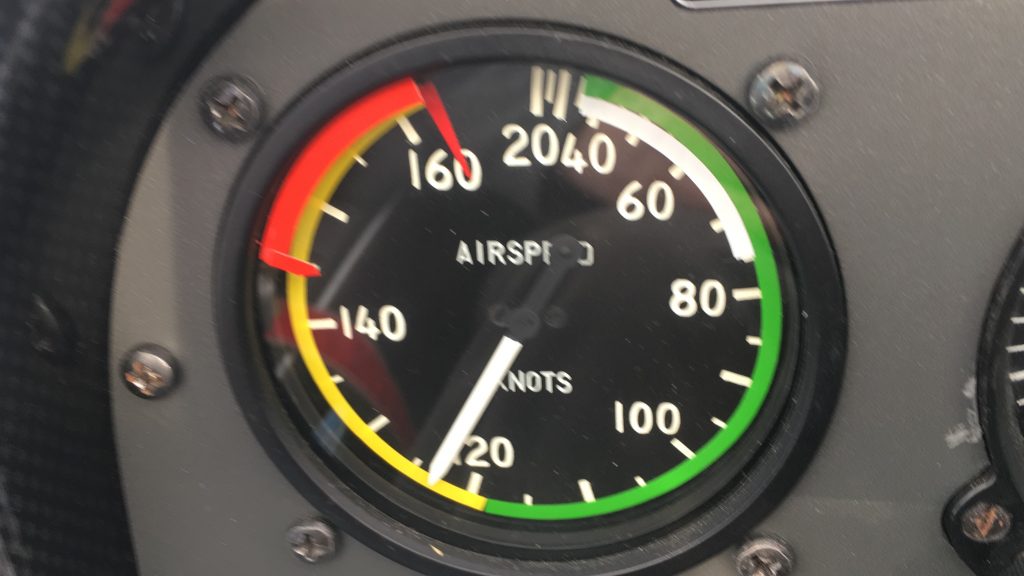
125 knots is pretty good on 100 horsepower. But as we said after the Sweden trip more speed, more baggage space and an autopilot would be handy.
We have recently returned from Dublin where we looked at, inspected and flew such a machine. Which was for sale.
More news soon! Watch this space…
If the tail falls off an aircraft in flight, it’s usually bad. It would not make for a very happy new year. It happened in the USA, to a Sting like ours. The whole horizontal stabiliser fell off and the aircraft ended up in a Florida field looking like this:
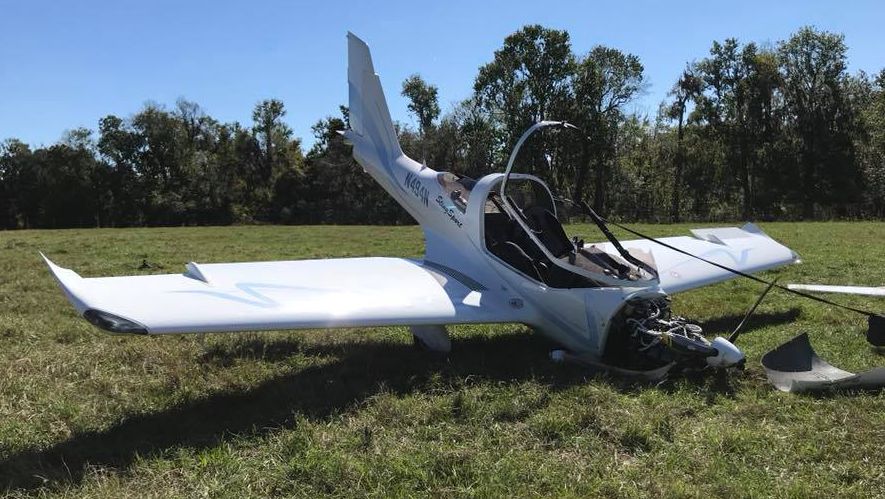
Pretty much wrecked, but the single occupant walked away. It probably would have been fatal if not for the built in parachute rescue system…
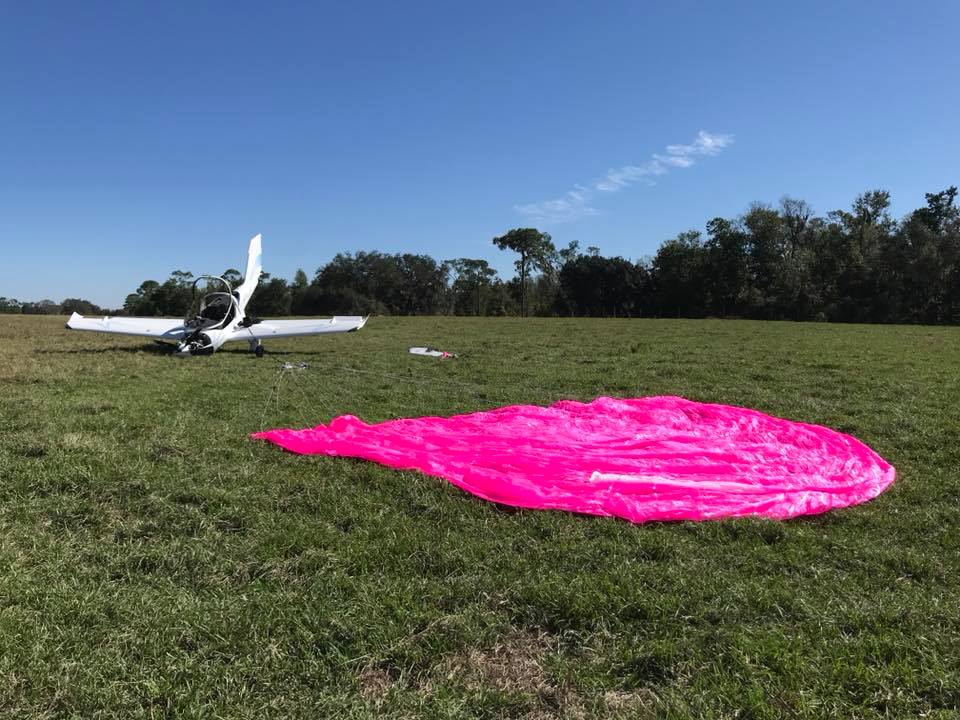
( Both crash photos courtesy of http://www.kathrynsreport.com/2018/11/tl-ultralight-sting-sport-n494n.html )
Because of this we had an Airworthiness Information Leaflet mandating an inspection of the horizontal stabiliser mounting pins within 5 flying hours and thereafter every year. Hearsay is that the mounting pins of the Florida crash aircraft were severely corroded.
Senior Engineer Brenda helped to remove the stab once the controls had been disconnected. Here she is peeling off silicone, the maintenance manual says the stab should be reattached in a bed of the stuff. It reduces vibration and helps keep the stab in place, but can be a real pain to remove once the tailplane is off the aircraft:
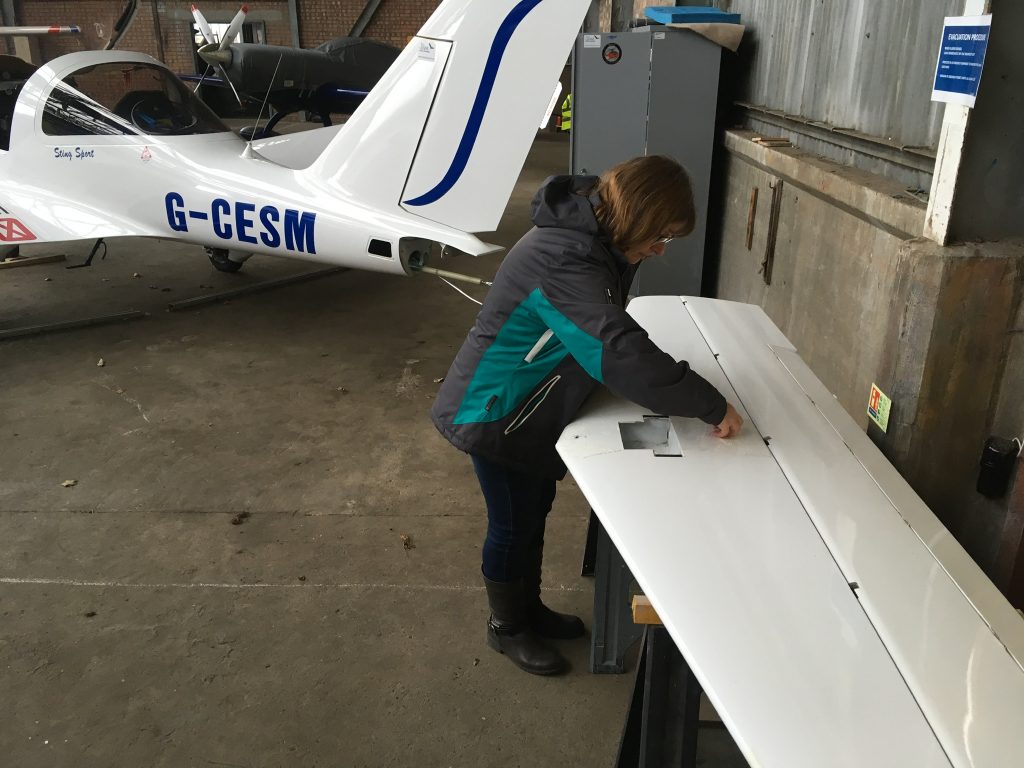
We also found a good use for our Nando’s card, it was great for gently scraping off the old silicone:
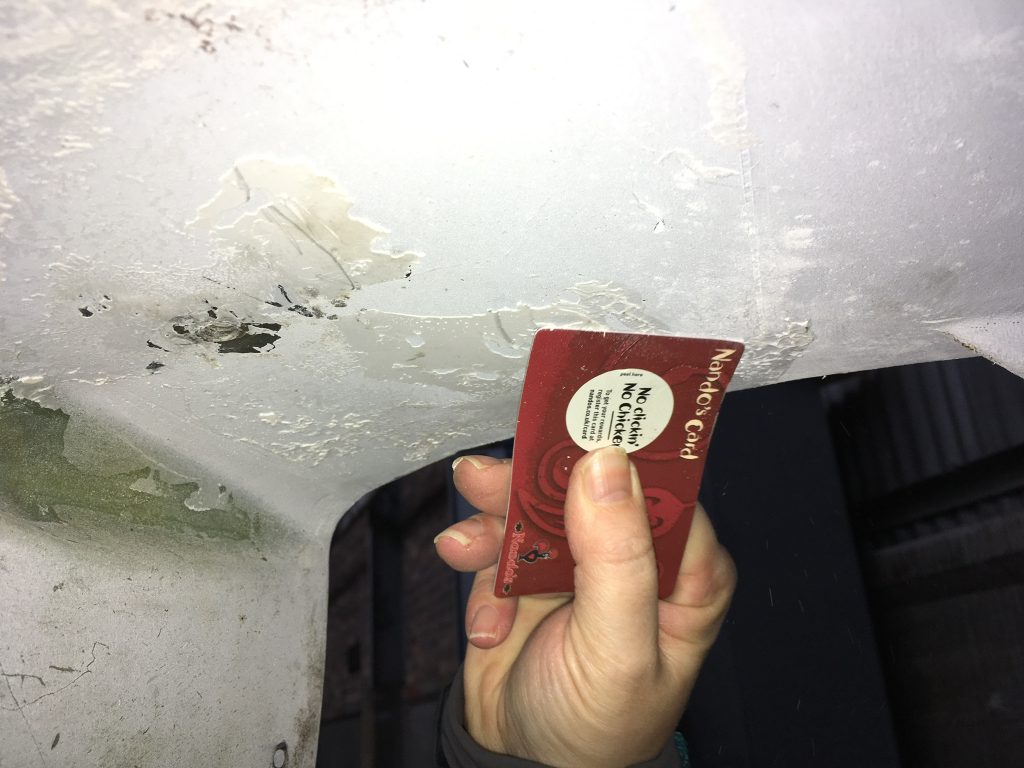
Our pins didn’t look corroded at all, nice and shiny. They passed the inspection and just needed a little polish and regreasing before reassembly:
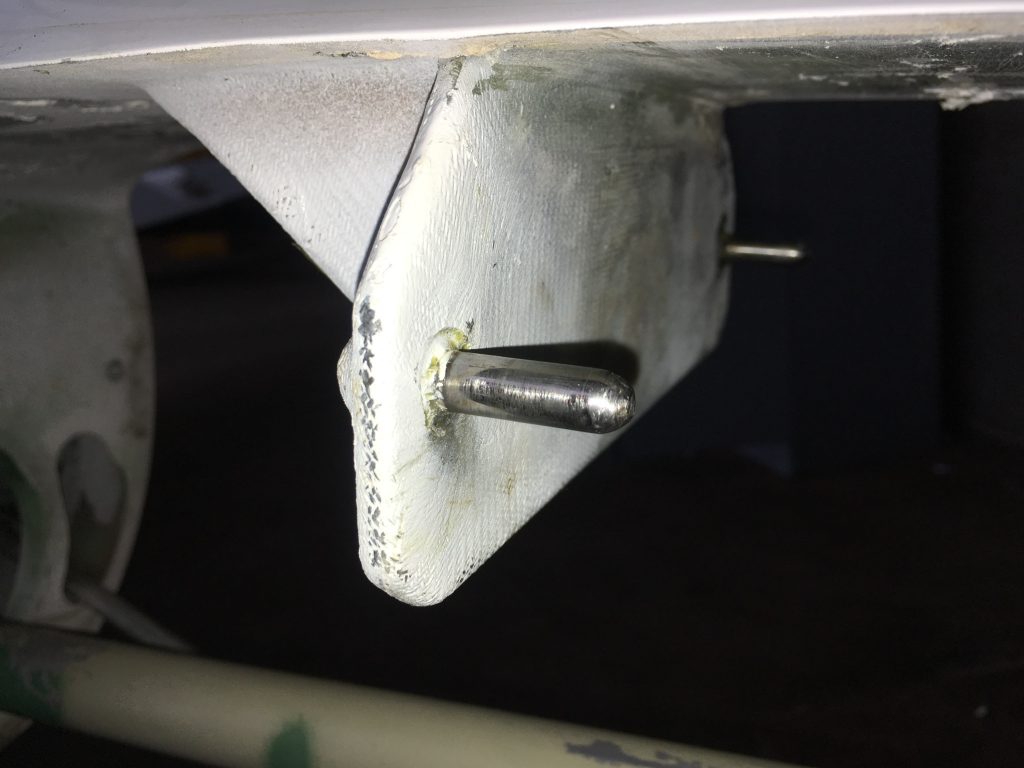
Once inspected, the world’s coolest copilot helped with the reassembly (Thank you, Rory), and then I did battle with reconnecting the controls. Lots of fiddly washers in the elevator and trim control connections:
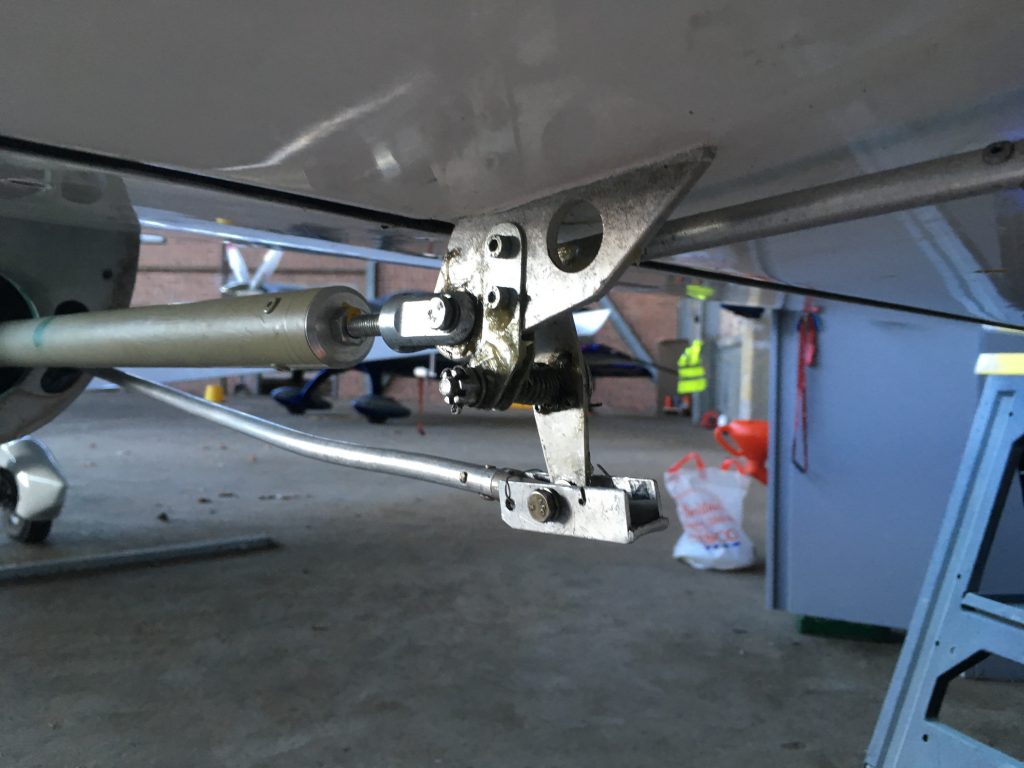
The connectors were reassembled “dry” with no grease, for ease of inspection, and then lubricated once inspected. Every critical system needs a duplicate inspection if it is disturbed; I do one as part of the reassembly process and Sandy my inspector does another, we both sign in the aircraft logbook.
Another reason for reassembling “dry” is that washers are very slippery and can ping off into the distance if given half a chance. Check the dark corners of any hangar and you’re bound to find one. Here’s the greased up final product:
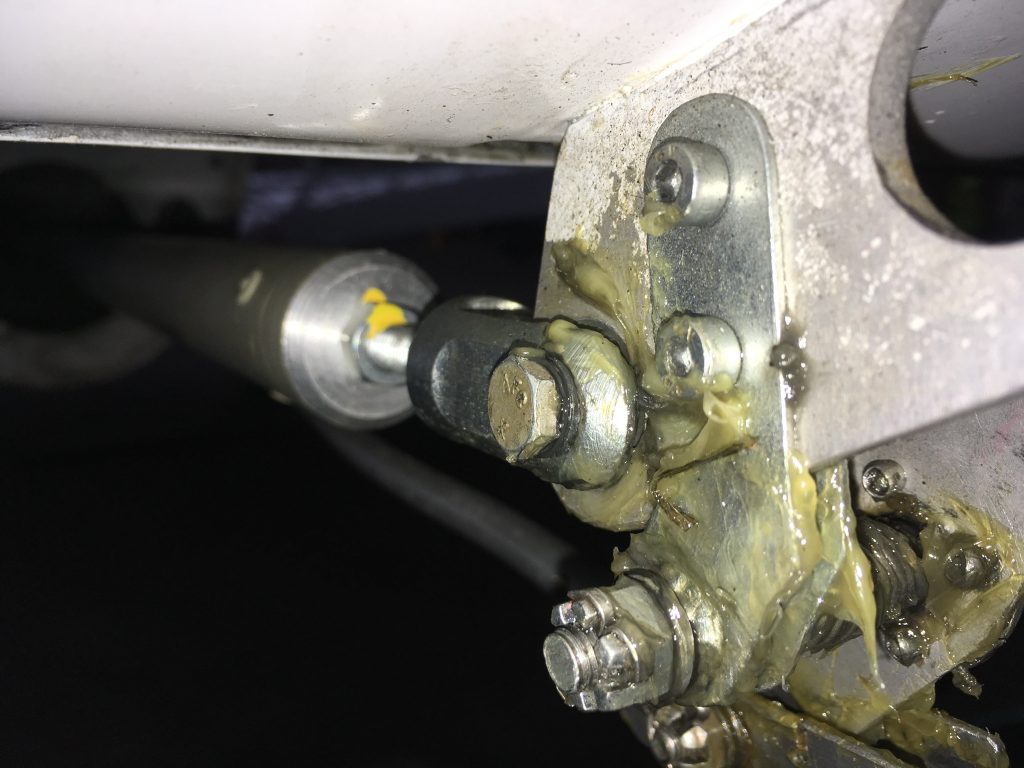
Finally came the wire locking of the mounting bolt and reattachment of the fairing. I was having a hell of a time holding the torch while wire locking and eventually ended up taping it to the elevator control rod. If only I had thought of that earlier…
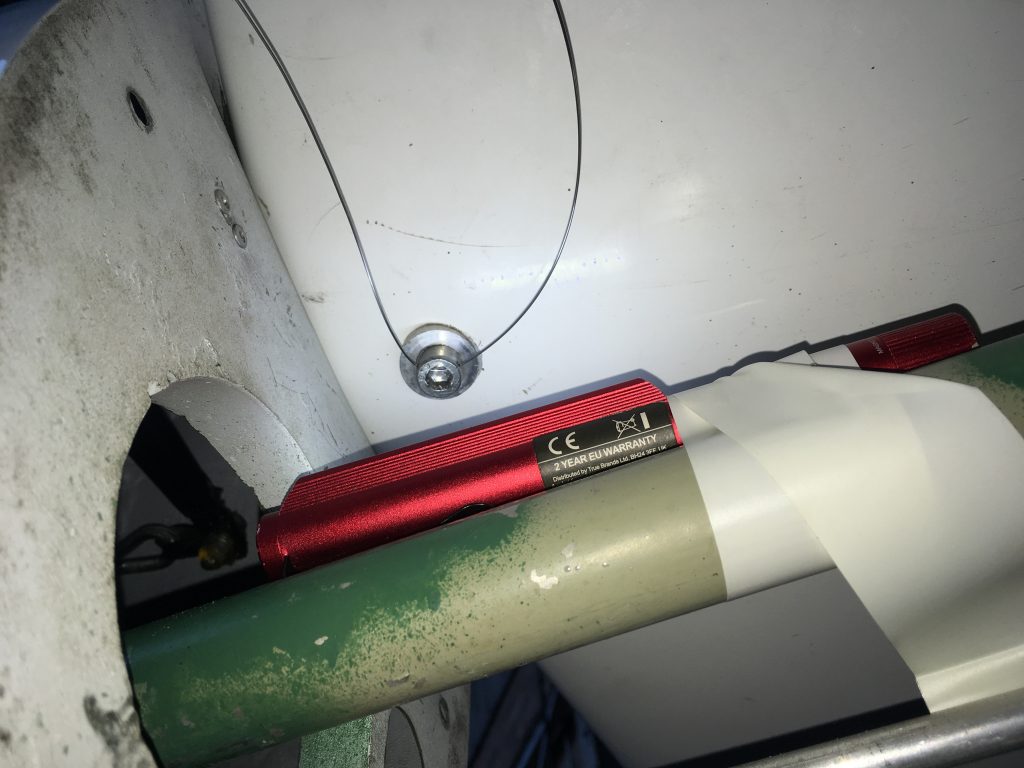
Aircraft inspected and reassembled, paperwork all in order and logbook signed up, it was time to go flying…
…and the engine wouldn’t start. The battery had been sitting in a (very) cold hangar for over a month and just wasn’t up to the job.
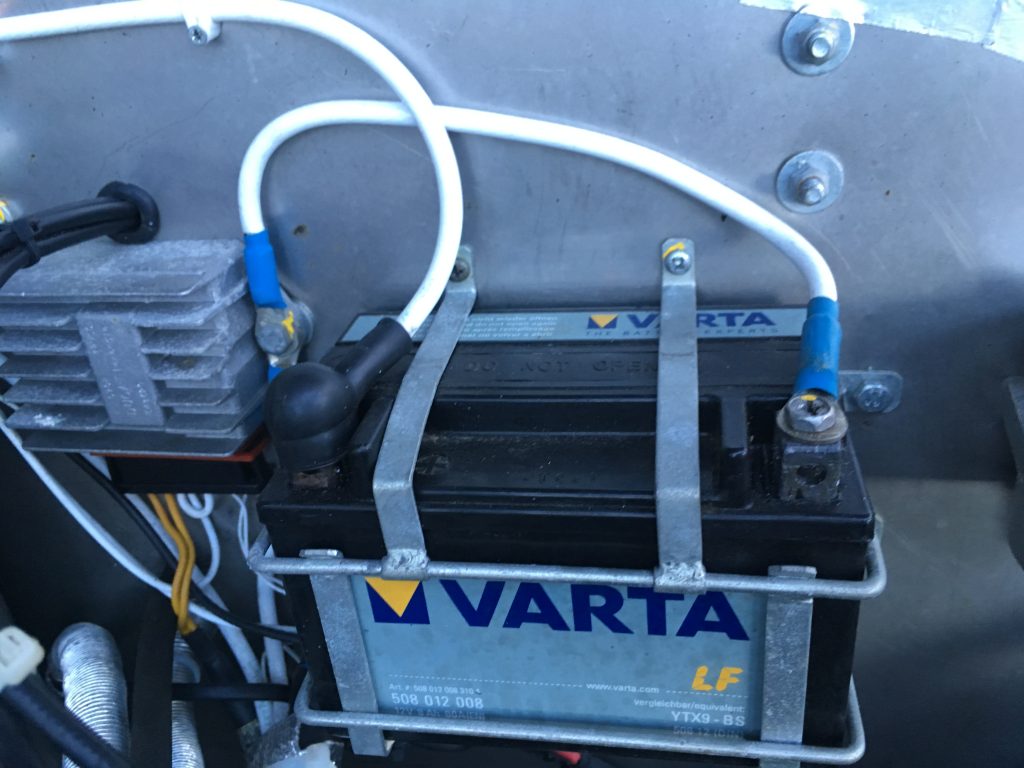
There are some awesome videos at “Sting Flight” on YouTube, see https://www.youtube.com/channel/UC0avm_9h4lpS5sIcQaBCQ_A – producer Rich DeHaven says that a battery lasts about 200 hours – ours has made it to 300 or so. It has done well but it’s about time for a change.
Luckily the battery in the Sting is a popular model, also used in quad bikes and snowmobiles, so it doesn’t have the big aviation markup normally associated with aircraft parts. A pleasant surprise to not pay through the nose for bits for the aircraft.
Just waiting for the new battery to arrive…the weather is lovely, and we’re stuck on the ground. Grrrrr.
Back from another Eindecker patrol over Strelitz Wood. Taken by paramedic Rich. As usual it took an hour to warm up after a 25 minute flight…
After appearing on Apple Maps (see Eindecker on iPad ) we now have a stalker cam at work…
See Perth Airport Webcam for the live feed…you might even see us fly!
Snow on the hills! And a day off with good weather, so time to try out the camera again – no iPhone pics this time, Canon EOS 1300D with 18-55 lens shooting at 18mm through the canopy at 1/320 in shutter priority. Just pointing and shooting and seeing what comes out…
This is taken from the edge of the hills looking south, with no snow in that direction:
Plenty of snow in the other direction
Cool cloud formations spilling over the peaks:
Looking up the A93 towards Glenshee Ski Centre:
Looking north towards the ski centre. The slopes on the east side of the road are called “Sunnyside” for some strange reason…
Still not enough snow for skiing, but it’s early yet. A good season on top of last year’s good season would be fantastic and would justify all the investment in new and refurbished lifts that the ski centre has put in over the last few years. It might also give us a bit of trade at work. Don’t want anybody to get hurt but it’s nice to be able to swoop in and take them to hospital when we can. It turns a 70 minute road journey by ambulance into a 20 minute flight. And the views are great…
Remember this?
Kortrijk is a sleepy little airfield. So sleepy that there is nobody to collect the landing fee…there’s a form to fill out and post in a box. Eventually they get around to sending a bill
We finally got the bill! Over two months later…